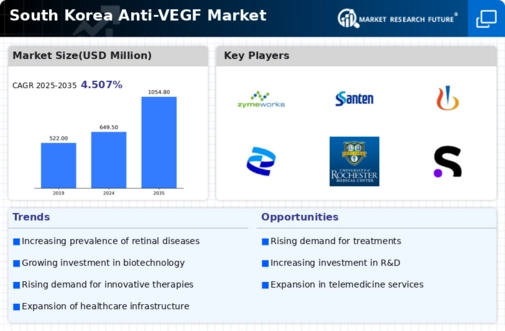Increasing Aging Population
The demographic shift towards an older population in South Korea is a crucial driver for the anti vegf market. As individuals age, the prevalence of age-related ocular diseases, such as age-related macular degeneration (AMD), rises significantly. This trend is evidenced by statistics indicating that approximately 15% of individuals aged 65 and older are affected by AMD. Consequently, the demand for anti vegf therapies is expected to increase, as these treatments are essential for managing such conditions. The anti vegf market is likely to experience substantial growth, driven by the need to address the visual impairments associated with aging. Furthermore, the increasing life expectancy in South Korea, projected to reach 85 years by 2030, suggests a sustained demand for effective ocular treatments, thereby reinforcing the market's expansion prospects.
Rising Healthcare Expenditure
The increasing healthcare expenditure in South Korea is a significant driver for the anti vegf market. With the government and private sectors investing heavily in healthcare infrastructure, the availability of advanced medical treatments is improving. In 2025, healthcare spending is projected to reach approximately $200 billion, reflecting a growth rate of around 5% annually. This increase in funding allows for better access to anti vegf therapies, which are essential for treating various ocular diseases. Furthermore, the South Korean government has been actively promoting initiatives to enhance the quality of healthcare services, which includes the reimbursement of innovative treatments. As a result, the anti vegf market is likely to benefit from this favorable financial environment, leading to increased adoption of these therapies among healthcare providers and patients alike.
Supportive Government Policies
Supportive government policies in South Korea are playing a vital role in shaping the anti vegf market. The government has implemented various initiatives aimed at enhancing access to innovative treatments, including anti vegf therapies. These policies often include subsidies and reimbursement programs that lower the financial burden on patients. In recent years, the government has allocated approximately $50 million to support research and development in the field of ophthalmology, which is expected to yield new anti vegf products. Additionally, regulatory frameworks have been streamlined to facilitate faster approval processes for new therapies, thereby encouraging pharmaceutical companies to invest in the anti vegf market. As a result, the anti vegf market is likely to experience accelerated growth, driven by these favorable governmental actions that promote innovation and accessibility.
Growing Awareness of Ocular Health
The rising awareness of ocular health among the South Korean population is a pivotal driver for the anti vegf market. Public health campaigns and educational initiatives have significantly increased knowledge regarding the importance of early detection and treatment of ocular diseases. As a result, more individuals are seeking regular eye examinations, leading to earlier diagnoses of conditions that require anti vegf therapies. This heightened awareness is reflected in a survey indicating that over 60% of respondents recognize the risks associated with untreated ocular diseases. Consequently, the demand for anti vegf treatments is expected to rise, as patients become more proactive in managing their eye health. The anti vegf market is likely to see a corresponding increase in treatment uptake, driven by this cultural shift towards prioritizing ocular health.
Technological Innovations in Treatment
Technological advancements in the development of anti vegf therapies are significantly influencing the anti vegf market in South Korea. Innovations such as sustained-release formulations and novel delivery systems enhance the efficacy and convenience of treatments. For instance, recent developments in injectable therapies have shown improved patient compliance and reduced treatment frequency. The market is projected to grow at a CAGR of approximately 8% over the next five years, driven by these innovations. Additionally, the integration of digital health technologies, such as telemedicine and remote monitoring, is likely to facilitate better patient management and adherence to treatment regimens. As a result, the anti vegf market is poised for growth, as these advancements not only improve patient outcomes but also expand the accessibility of treatments across various demographics.






















Leave a Comment